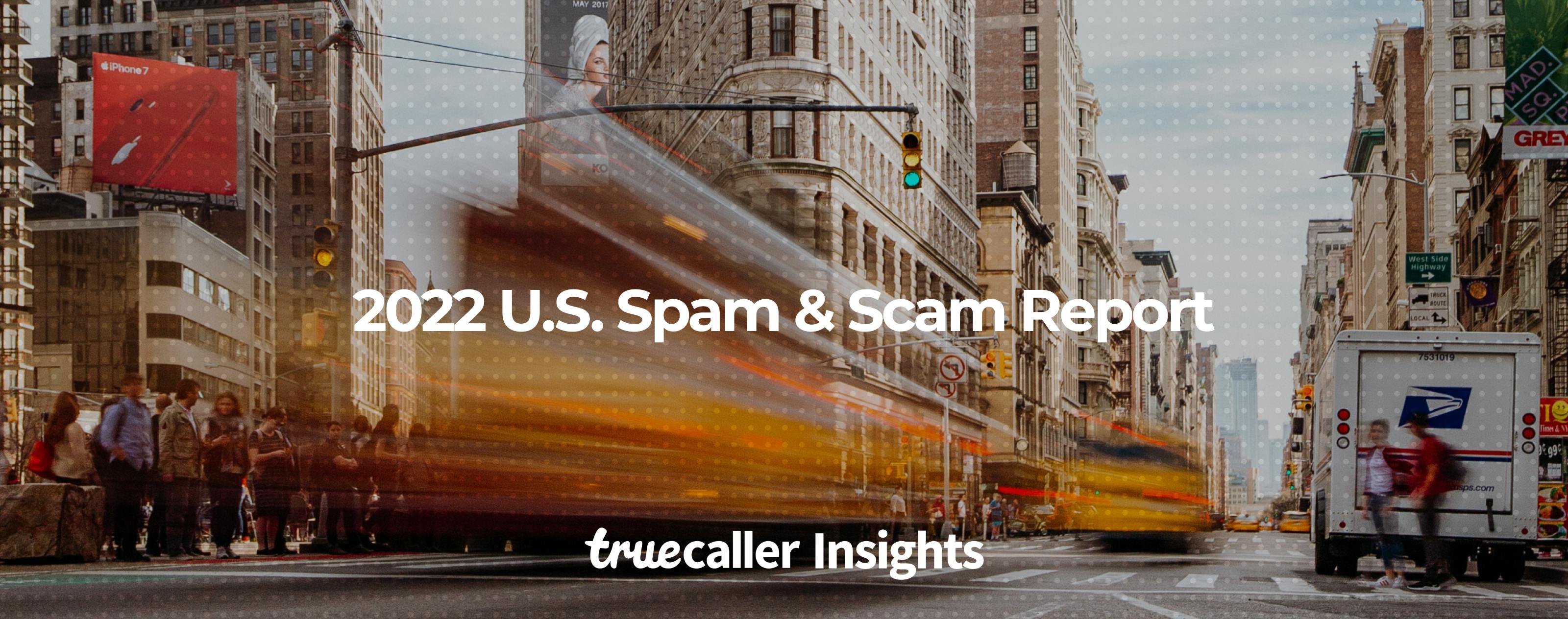
Truecaller Insights 2022 U.S. Spam & Scam Report
Truecaller
May 24, 202212 min read
It’s time for the 8th Annual edition of the Truecaller Insights US Spam & Scam Report. Phone scams are relentless and the numbers don’t lie. A staggering $39.5 billion USD* was lost to phone scams in America over the past 12 months. Please read on for further findings.
Access the full report at: https://tclr.se/US2022Report
How to best Prevent Spam (According to Truecaller):
At Truecaller, we believe our solution for blocking spam is superior. A mixture of a strong, community-based system combined with advanced machine learning, provides the best protection for people across the world. We’ve learnt over the years that scammers and spammers are crafty. When regulation or laws pop-up, they find ways around them. That is why there is no quick or easy fix to scams, unless you harness the power of a community like Truecaller’s.
US Spam and Scam Report – Introduction
Key Findings
- As many as 68.4M Americans (26%) report losing money from phone scams – up from 59.4 million (23%) in 2021.
- 1 in 3 Americans (33%) report having ever fallen victim to phone scams, with 20% more than once.
Of those who lost money to phone scams in the past 12 months: - The average reported loss was $577 – up from $502 in 2021.
- Robocallers duped 61.1% of these people.
- The money lost to scam calls in the past 12 months equates to an estimated $39.5 billion USD*.
- The number of spam calls received by Americans actually increased (albeit marginally) compared to the previous year. This indicates that the STIR/SHAKEN protocols have not had the desired effect.
- Hispanics are more vulnerable to scams. 28.5 million Hispanics (46%) report falling victim to phone scams compared to 33% of the general population.
- When scammed, 43% of people take the immediate step of finding and downloading a spam blocker and/or caller ID app.
- Spammers appear to be using text messages far more this year. Spam texts have more than doubled over the previous 3 years. Males over 65 years old are the biggest targets.
68.4 million Americans have fallen victim to a phone scam in the past 12 months
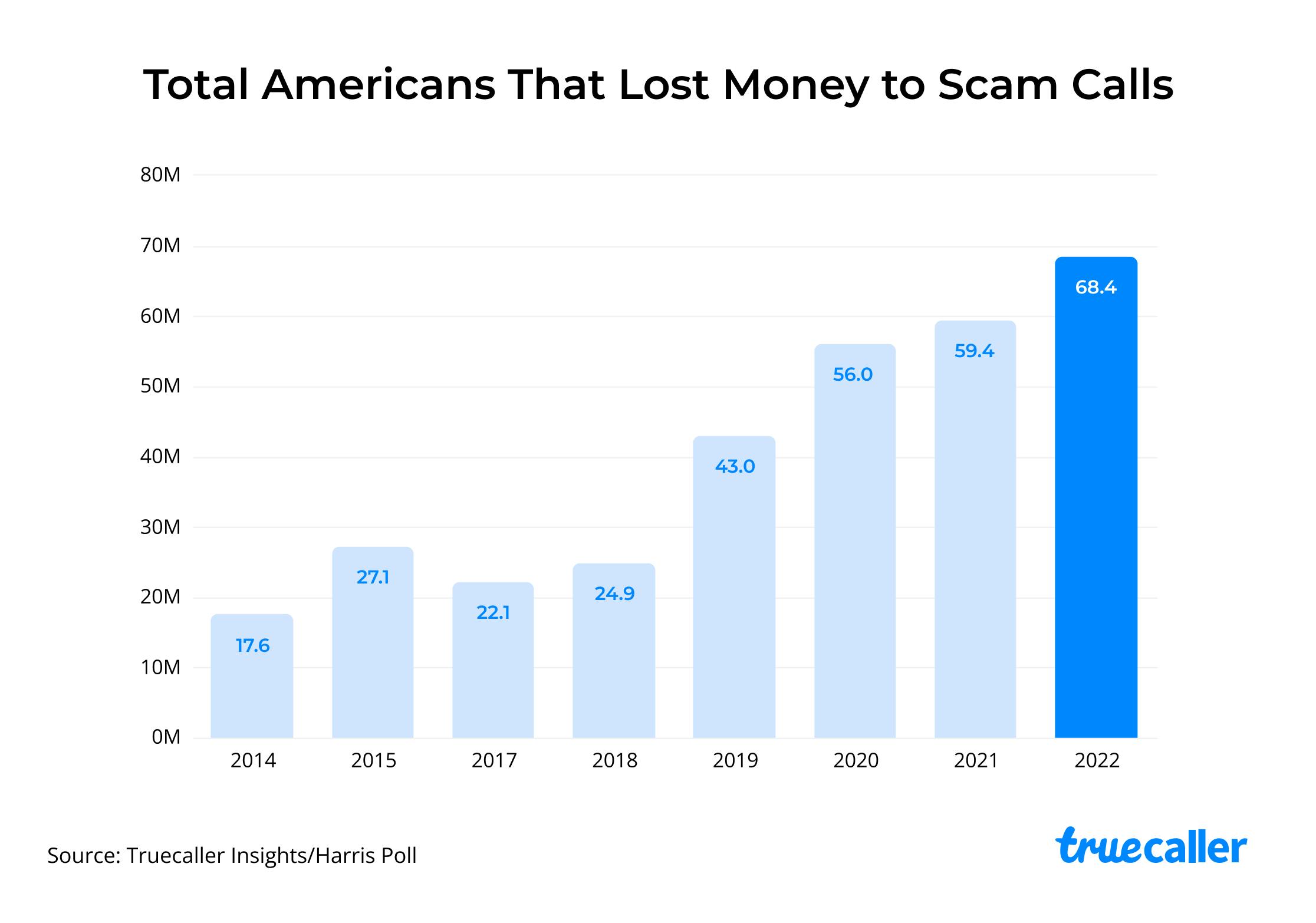
In the past 12 months, over 68.4 million Americans lost money to phone scams. This is a clear increase compared to last year’s 59.4 million and 56 million from 2020. Once again, this is the highest number recorded since we started researching scam and spam calls in the US 8 years ago.
This is also despite Congress mandating the STIR/SHAKEN framework.This set of standards was supposed to protect Americans from robocallers and scammers. Unfortunately, it looks like scammers are finding ways to sidestep regulation by the government, and continue to defraud more people of their money.
Losses to phone scams totalled $39.5 billion USD in the past 12 months
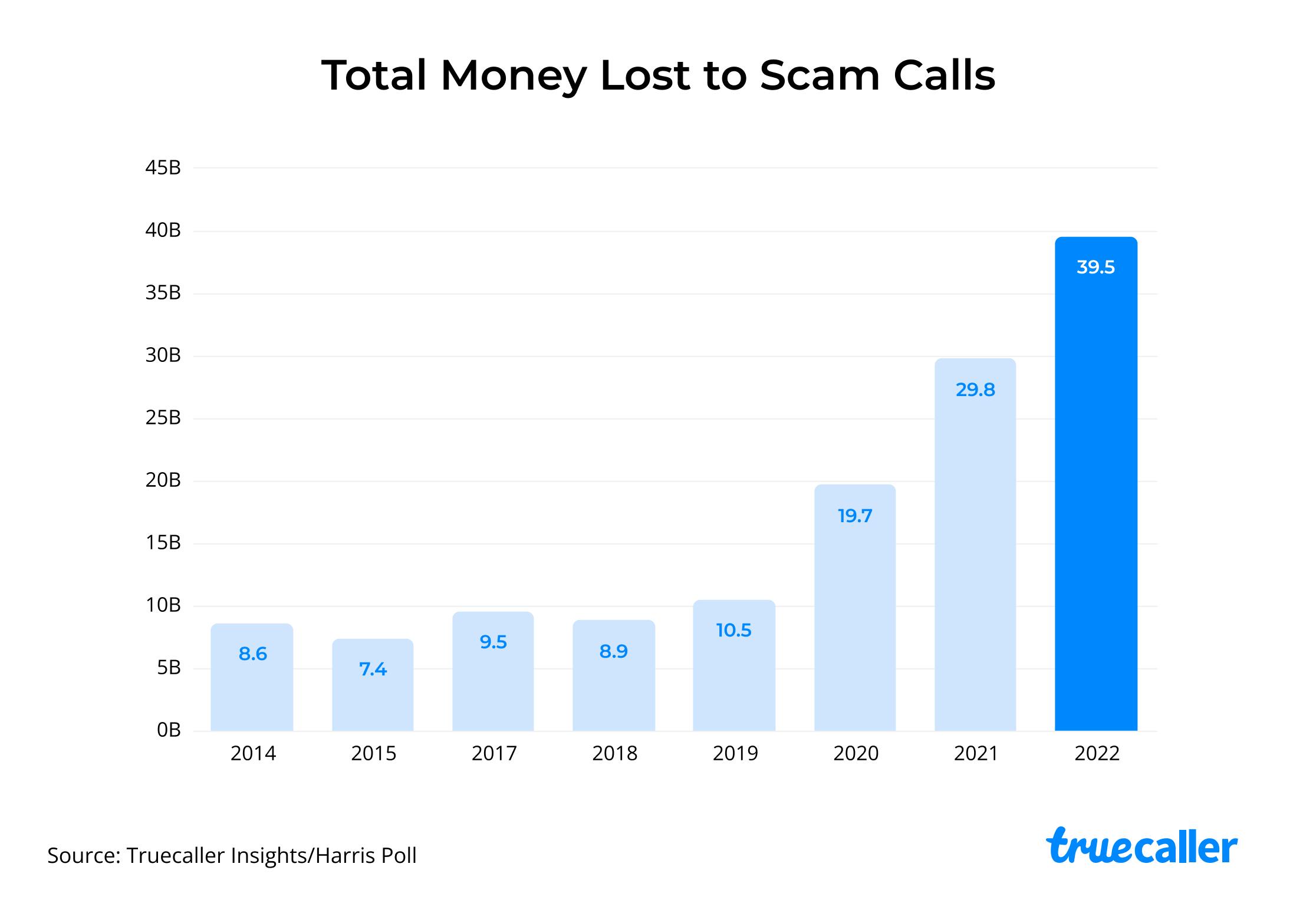
Over the past eight years, the total money lost to scam calls in the US has been growing significantly. In just the past 12 months, an estimated $39.5 billion USD* was lost to phone scams. This is a 32.5% increase compared to last year’s $29.8 billion USD.
To put this into perspective, $39.5 billion is the same amount of money as giving $1000 dollars to every person in California.
The total money lost to scams is also comparable to the American Rescue Plan Act’s entire childcare budget of $39 billion. If phone scam fraud was somehow eliminated, the amount saved could fund federally subsidized child care across the U.S. for a full year to help families and employers.
The average reported loss to scam calls has increased 14.9% in the past 12 months
Among those affected by scam calls, the average money lost was $577 USD. This is a 14.9% increase compared to last year ($502 USD).
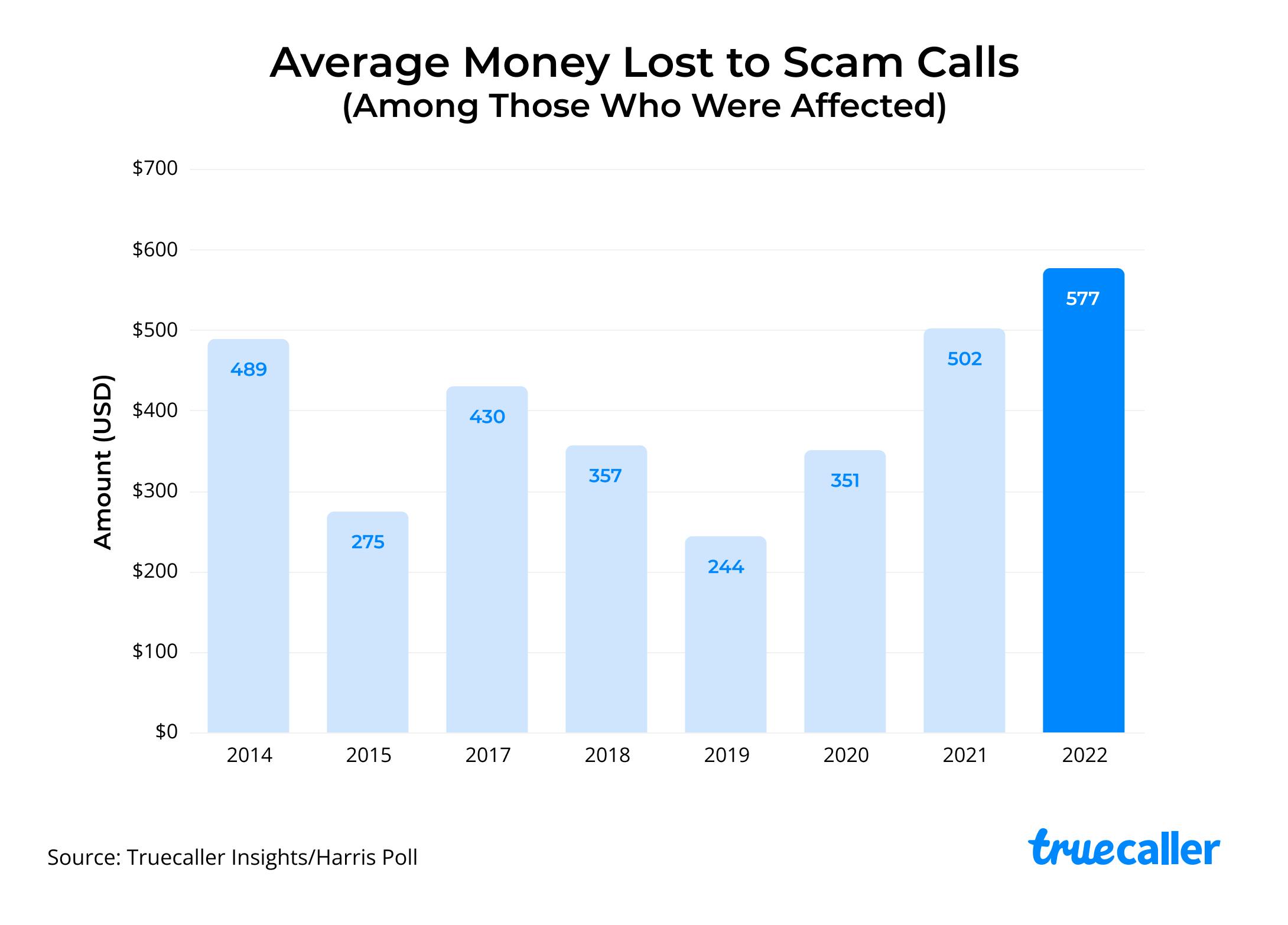
The graph above shows the trend over the past eight years. While there was a downward trend in 2015 and 2019, the past 12 months have recorded the highest ever average amount of money lost to phone scams.
Scams from robocalls remain a big problem in the U.S.
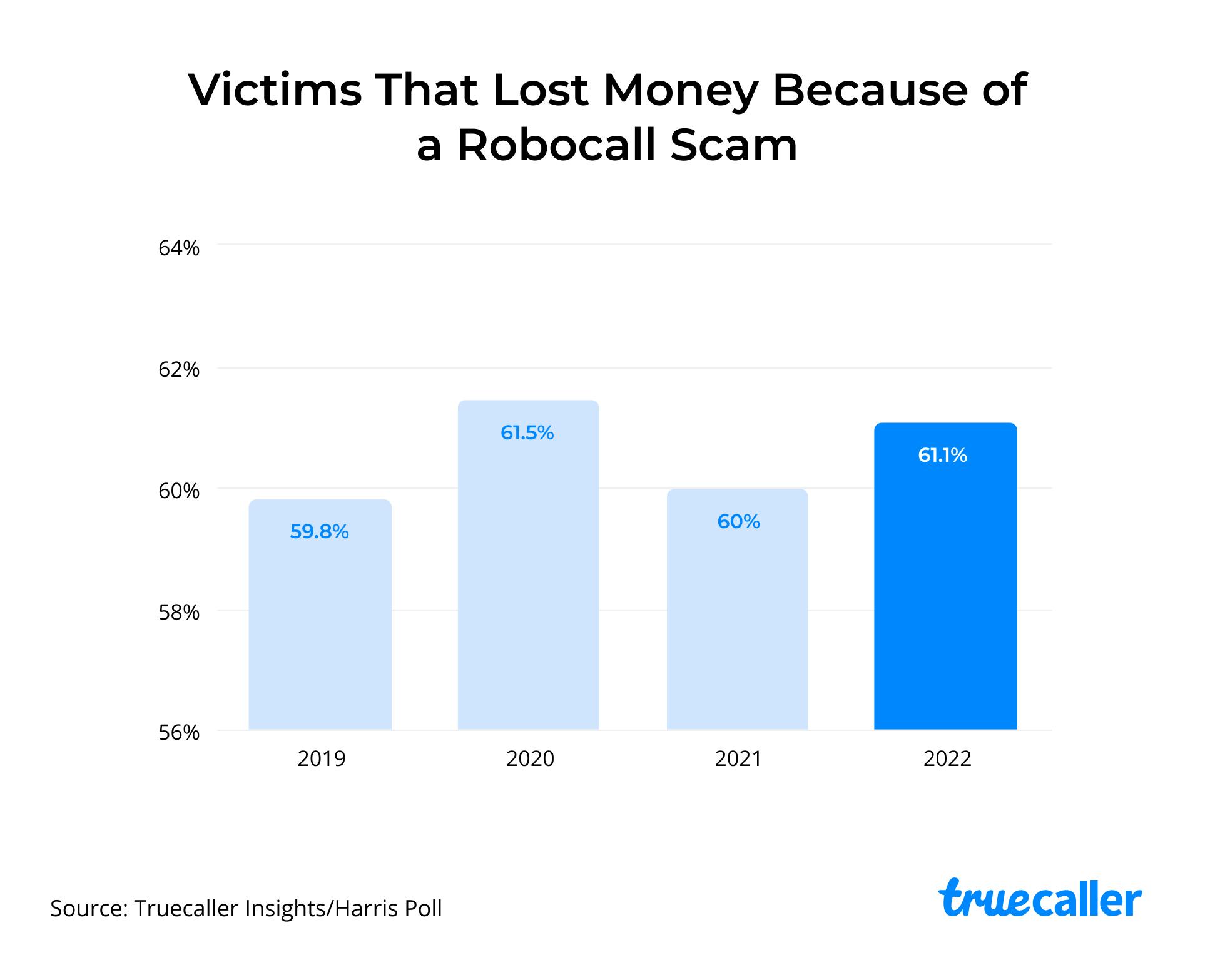
The number of victims who lose money to a robocall scam continues to be a big problem. 3 in 5 Americans who have lost money to phone scams (61.1%) admit to losing money as the direct result of a robocall. Just a friendly reminder here, according to the Federal Trade Commission (FTC) , any robocall trying to sell you something is illegal. The only exception is if the caller has written permission, directly from you, to call you in this way.
The FTC also states that even if you have given such permission to a company in the past, you always retain the right to revoke that permission at any time.
Men more likely than women to be scammed
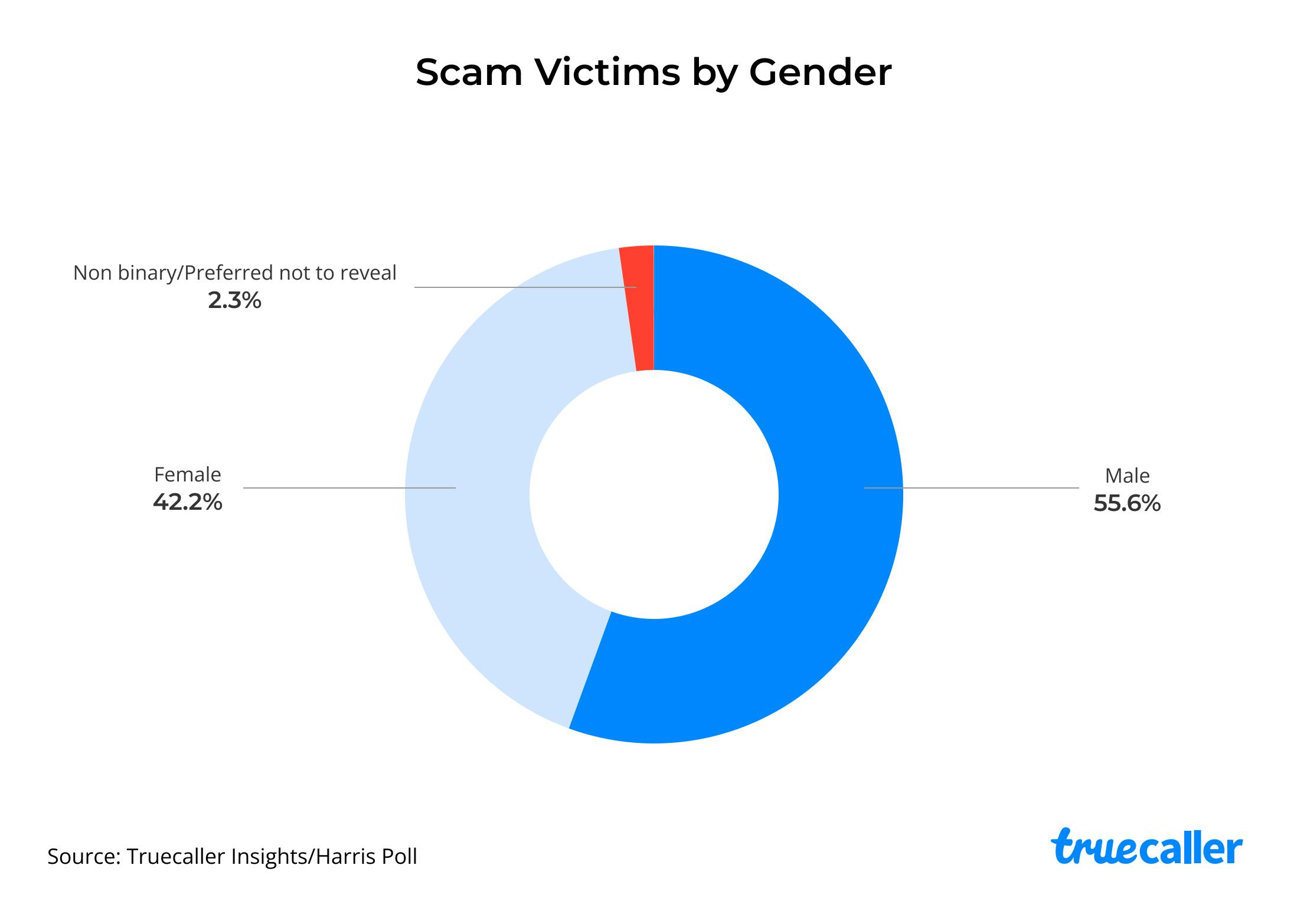
In the past 12 months, of those who have been victim to phone scams, 55.6% were men and 42.2% were women. The rest (2.3%) of those who participated identify as non-binary or preferred not to reveal their gender.
Similar to previous years, younger men and women between the ages of 18-44 years are more susceptible to phone scams
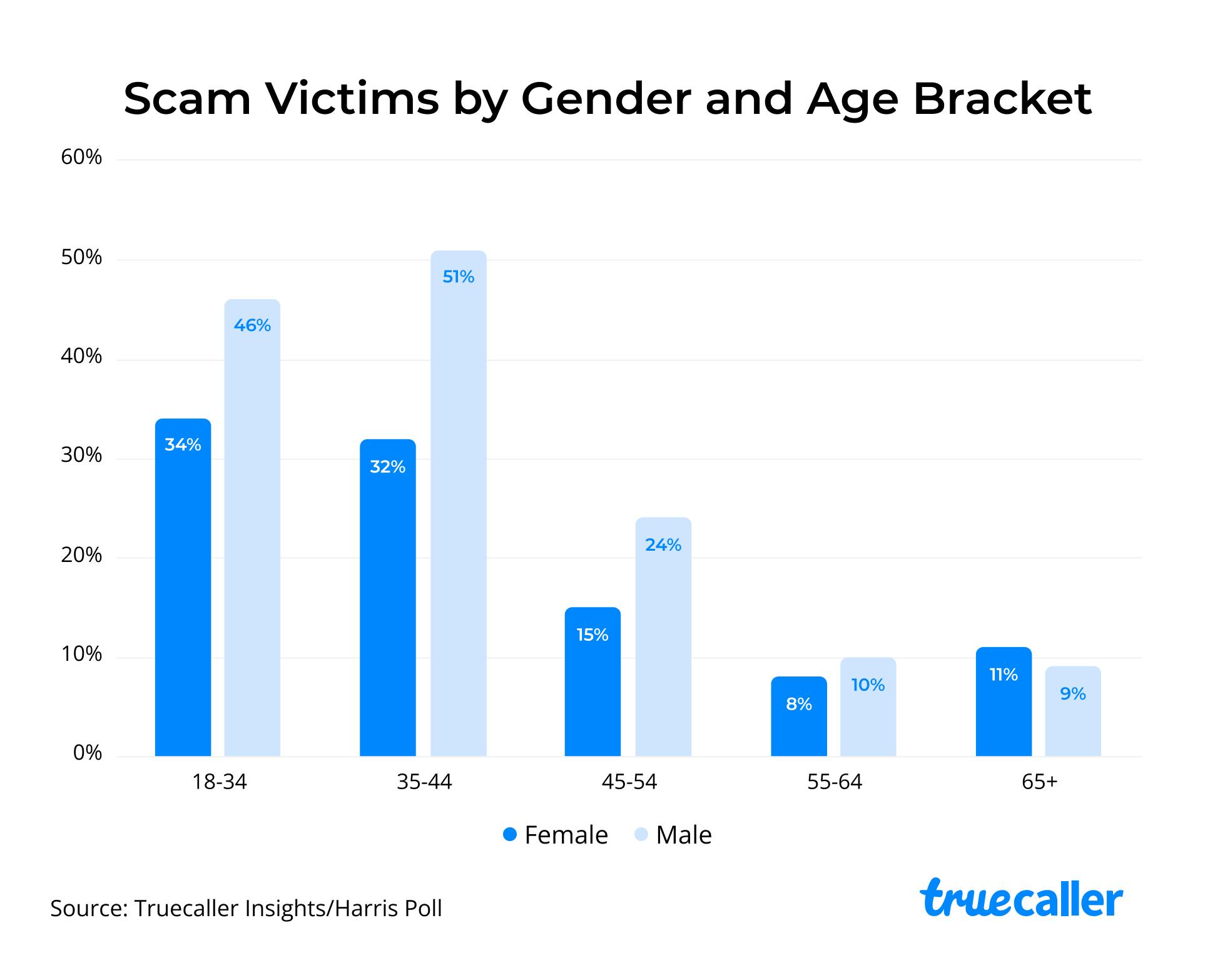
Younger men are more likely than older men to lose money to a phone scam, particularly men aged 18-34 (46%) and age 35-44 (51%), compared to men aged 45-54 (24%). Among women, the age groups that are most susceptible are also 18-34 years olds (34%) and 35-44 year olds (32%).
Downloading a spam blocker/caller ID app continues to be the predominant action after being scammed
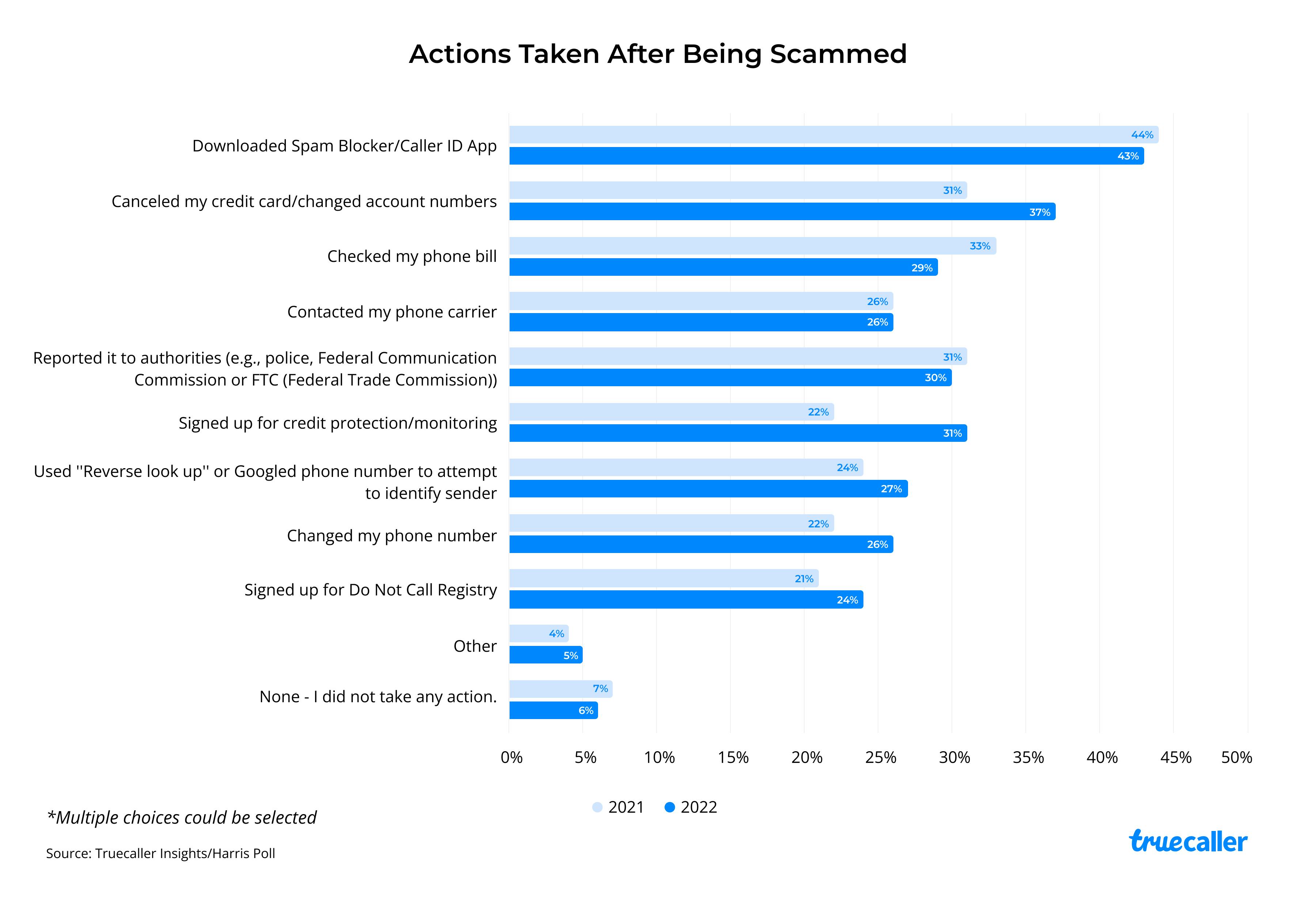
When scammed, 43% of people downloaded a spam blocker and/or caller ID app. 37% took the inconvenient step of canceling their credit card/changing account numbers. Another 30% took the trouble of reporting the scam to the authorities.
When money is lost to a phone scam, higher income groups are more likely to take action (99% vs. 88% for household income less than $50K). This trend increases in groups along with an increase in income.
Despite these actions, a new question from this year’s research has revealed that: 25% say they have missed legitimate calls because of brute-force blocking (i.e., extreme and inaccurate spam filtering). This shows that many spam filters are not working effectively, and are not building more trust in communication, but in fact the opposite. It also proves that improved caller identification, more precise spam analytics and future innovation within call screening is important to improving the communication environment within the country.
On average, Americans received nearly 31 spam calls per user per month. This is slightly above the average of 30.7 calls per user per month in the previous year
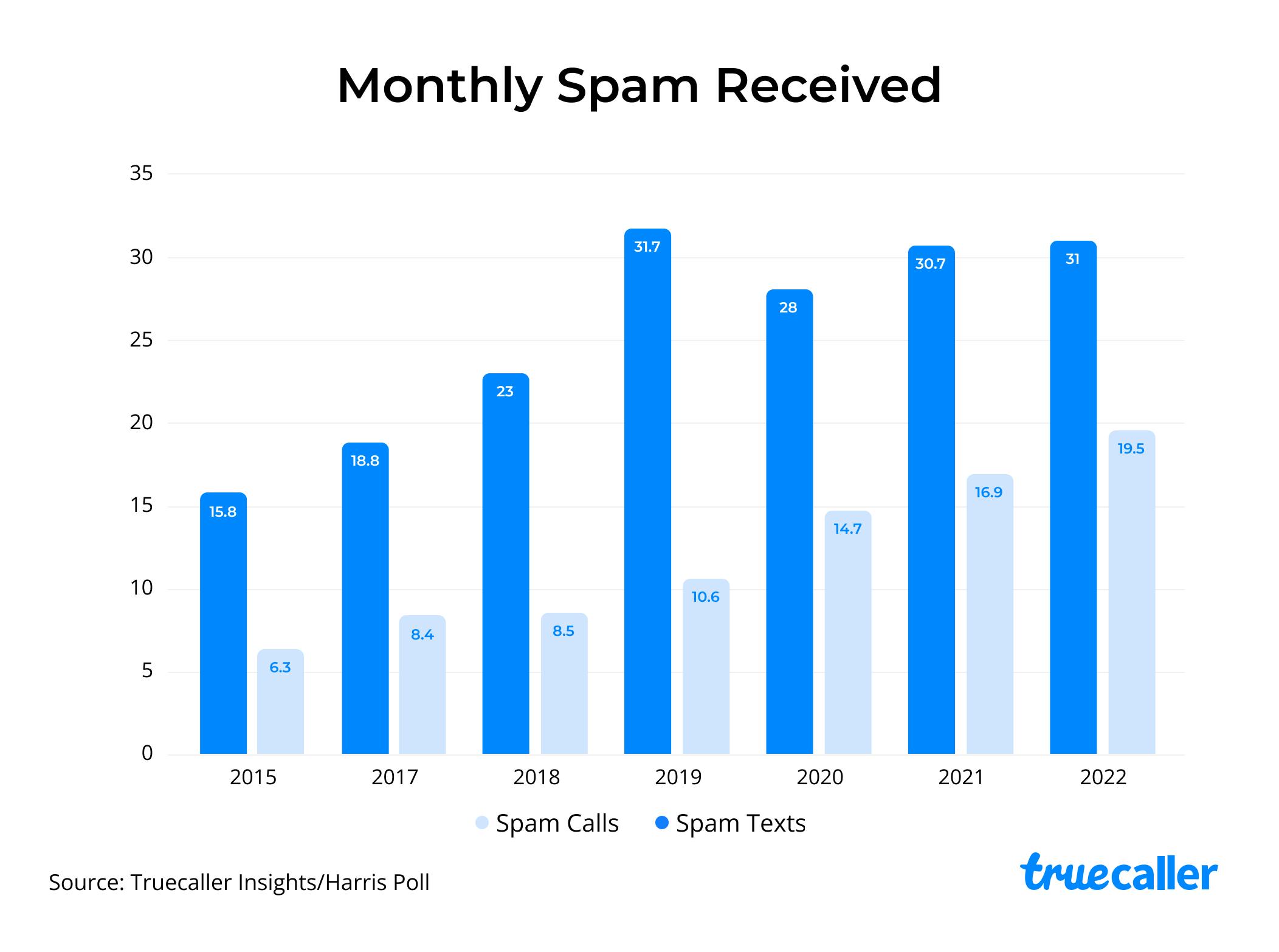
Key Spam Stats from the 2022 US Spam and Scam Report
This year, Americans received 31 spam calls in an average month (no significant increase from 30.7 in 2021). Of these, 21.5 on average were robocalls.
Nearly 3 in 5 Americans (58%) reported receiving more spam calls and/or text messages than they did a year ago. 14% said they received fewer.
Nearly 9 in 10 (86%) said they try to only answer calls if they can identify the person or business calling. This clearly highlights the need for an efficient and accurate caller ID service.
The average number of spam texts per month is 19.5, continuing significant year-on-year increases since 2019 (16.9 in 2021,14.7 in 2020, 10.6 in 2019 and 8.5 in 2018).
If they received a call from an unknown number, 67% of Americans would completely ignore it. If they received a text from an unknown number, 65% of Americans said they would delete it.
New Data in the 2022 US Spam and Scam Report
Demographics – Ethnicity
In 2022, we added extra data to help further understand who are most vulnerable to spams and scams. Part of this was research into the racial breakdown of spam and scam victims.
Analysis found that Hispanics, although they receive less spam calls and texts when compared to Black and White respondents, were more likely to have been a victim of a phone scam in their lifetime. Hispanics also report that when they lost money (due to a phone scam), it was mostly by a robocall. This stat showed a surprisingly large difference, 74% compared to 43% and 65% of Black and White adults respectively. Based on their responses, it is observed that CallerID accuracy for the Hispanic population is comparatively less (47% vs 54% & 53% for Black and White respectively).
Call from an unknown number
With respect to race/ethnicity, Whites (Non Hispanics) are more likely to answer a call if they can identify the person or business they are calling from compared to Black(Non Hispanics) and Hispanics (89% vs. 82% and 81%) .
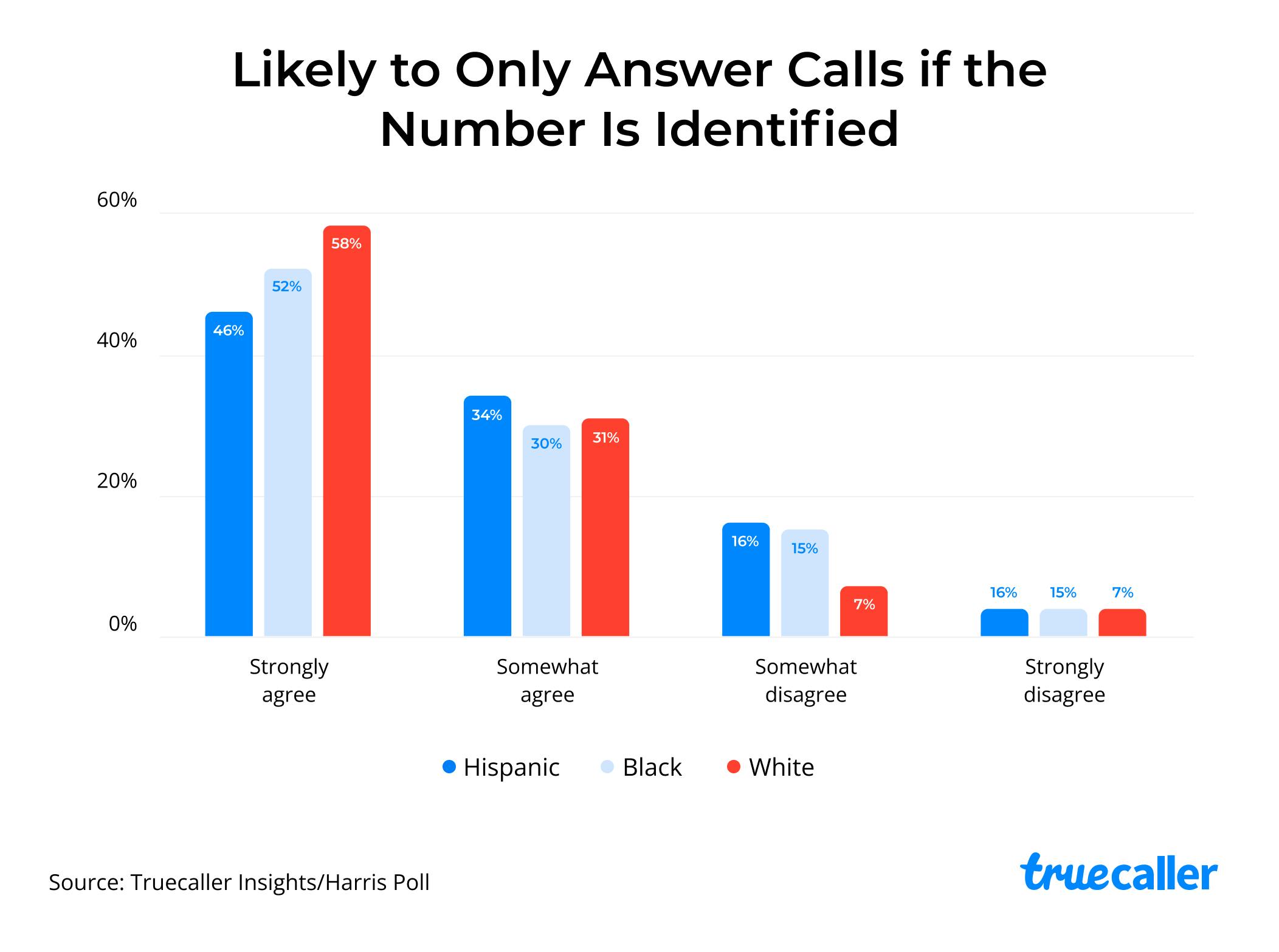
Neighbor Spoofing
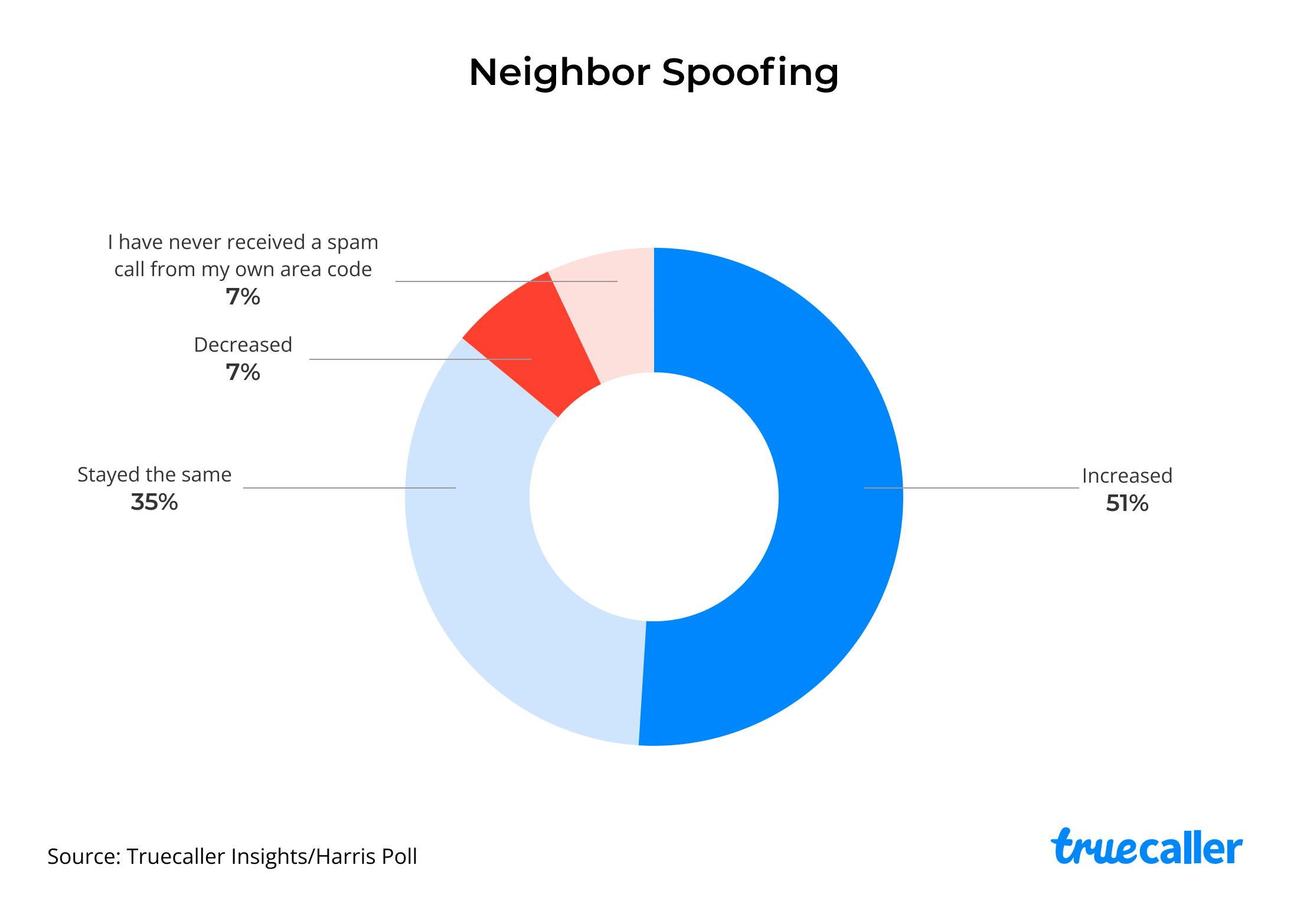
We asked respondents if the number of spam calls they receive with a spoofed location (i.e., neighbor spoofing, or spam calls displaying your area code) has increased, decreased or stayed the same in the past 12 months.
Just over half of Americans (51%) report that the number of spam calls they receive with neighbor spoofing has increased in the past 12 months. 35% said it stayed the same. Only 7% report a decrease in these types of calls. This is surprising to us. After the Stir/Shaken protocol was mandated, we were expecting a reduction in neighbor spoofing. Although it is a step in the right direction for legislation, it is clear that Stir/Shaken has been somewhat ineffective.
From our analysis, it seems that with an increase in age, household income or higher education, Americans receive more spam calls from the same area code.
The research revealed that adults above 35 years of age are more likely than those between 18-34 to report an increase in this type of call (56% vs. 39%). Those with a household income (HHI) of $75k+ are more likely than those with HHI of less than $50k to report an increase in this type of call (56% vs. 46%). Those with college education are more likely than those with higher secondary education (or less) to report an increase (56% vs. 43%).
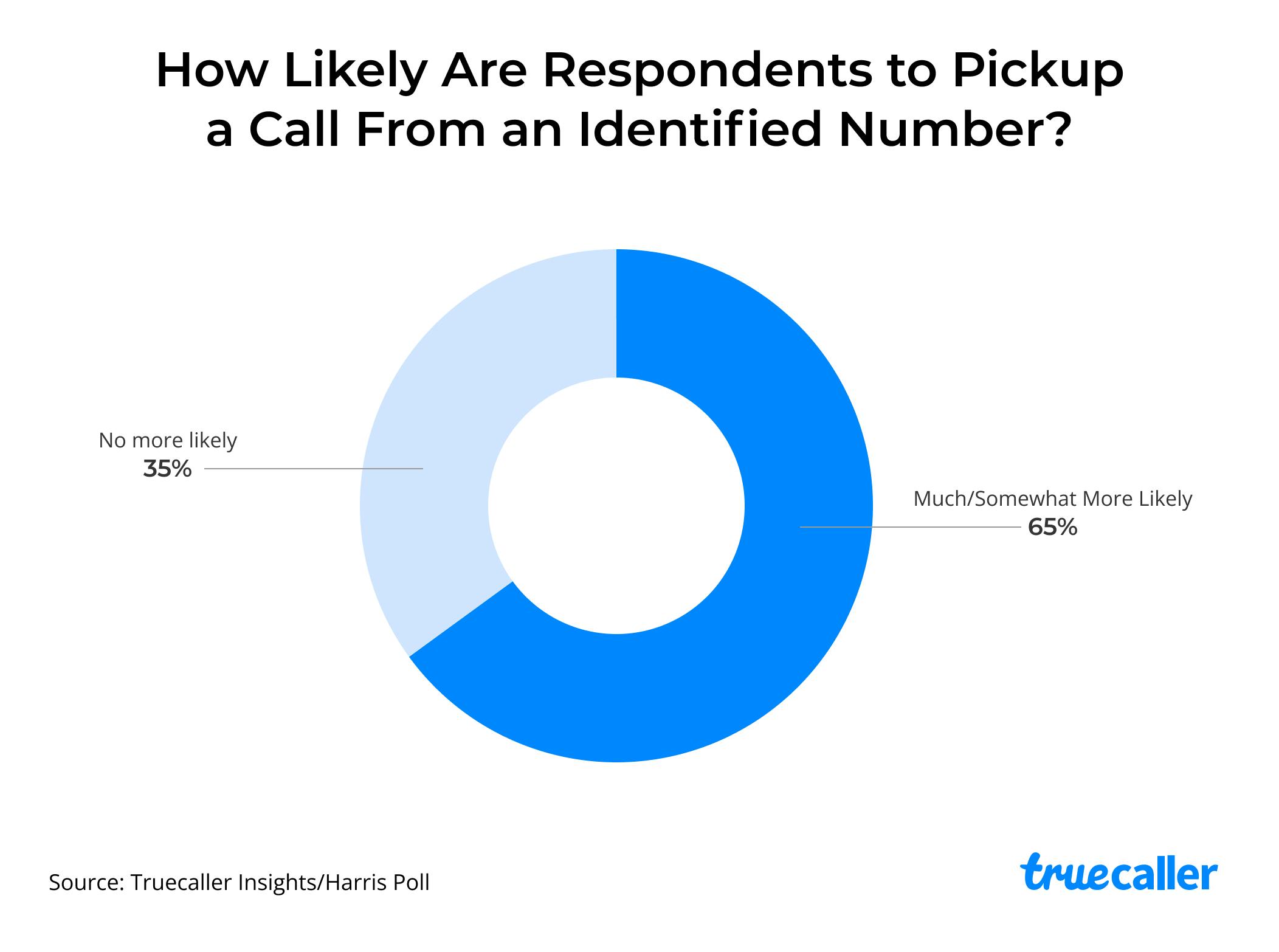
This year, we asked if respondents are more likely to answer calls from an unknown number if they are clearly identified as an important organization (for instance, a school, business, hospital, airline, contractor, delivery and so on).
65% of Americans say they are more likely to answer calls from an unknown number if they are clearly identified as important organizations.
Younger men and women (18-44) are more likely to answer calls from an unknown number if they are clearly identified as important organizations (76% vs. 56% ages 45+).
US Spam and Scam Report
Communication is changing
A whopping 86% of Americans try to only answer calls if they can identify the person or business they are calling from. Getting in touch via calls is now becoming socially less acceptable.
60% of Americans prefer to use other methods for communicating (e.g., text, social media apps, email) to avoid phone calls altogether. This could indicate many things, such as:
1. Spam phone calls and robocalls have created an environment of great distrust among society with this method of communication.
2. Modern forms of communicating, that require less immediacy are more preferred than being put on the spot by a phone call.
As to the exact reasons for the aforementioned stats, that is unclear. But despite the majority of people only answering calls from known numbers, they may miss legitimate calls because they suspect they are spam and don’t answer.
More than half (51%) of Americans find it difficult to reach other people via phone calls because many ignore phone calls in an effort to avoid spam.
At Truecaller, this represents a large need, and validation, for our efforts in identifying and verifying callers.
Robocalls and Robotexts
Overall, 97% of Americans say they have received a robocall. 3% say they haven’t received any robocall in the past 12 months.

According to the survey, vehicle warranties (60%) tops the list of types of robocalls Americans have received in the past 12 months. Other types of Robocalls includeMedicare (37%), Money owed for tax or legal fines (34%), Offers to switch or bundle mobile, cable TV or satellite TV providers (32%), Sweepstakes/Lotteries (30%), IRS or tax related (29%), social security number related (29%) and cryptocurrencies (14%).
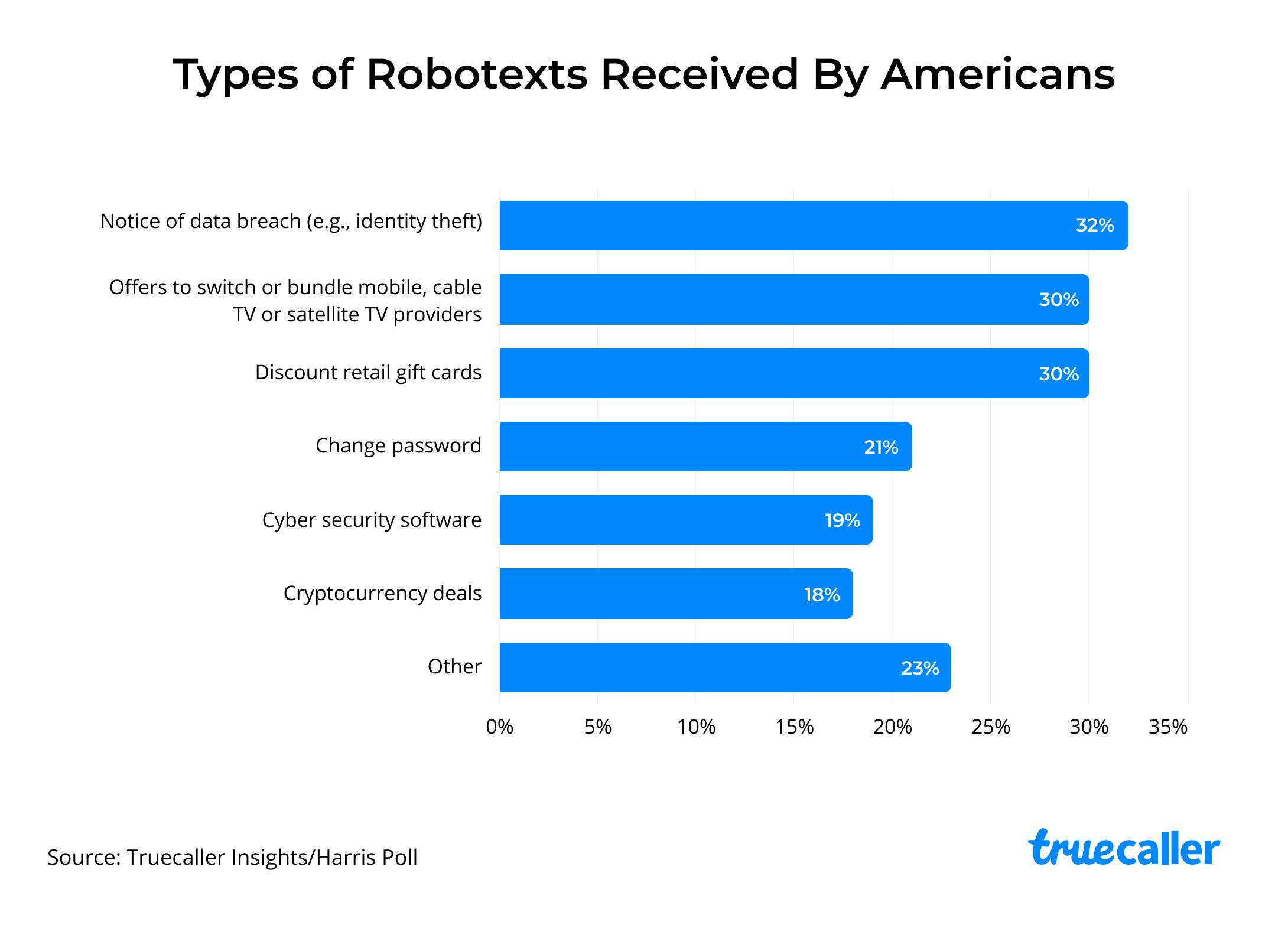
Notices of data breaches (for example, identity theft) top the list of types of robotexts that Americans have received in the past 12 months, with 32% reporting it. Other types of robotexts includes offers to switch or bundle mobile, cable TV or satellite TV providers (30%), discount retail gift cards (30%), password changes (21%), cyber security software (19%) and cryptocurrency deals (18%).
85% of Americans say they have received a robotext (of any type). 15% say they haven’t received any robotext in the past 12 months.
Demographics – Age
American seniors (ages 65+) report a higher average of monthly spam calls than their younger counterparts (50.4 vs. 20.3 ages 18-34, 22.3 ages 35-44, 29.8 ages 45-54 and 33.8 ages 55-65).
It is also observed that 66% of Americans aged 65+ reported receiving higher spam calls and spam texts compared to a year ago.
Contrary to spam calls received, younger Americans are more likely to lose money to a phone scam compared to their older counterparts (41% vs. 20% ages 45-54, 9% ages 55-64 and 10% ages 65+). Younger adults are also more susceptible to robocall scams.
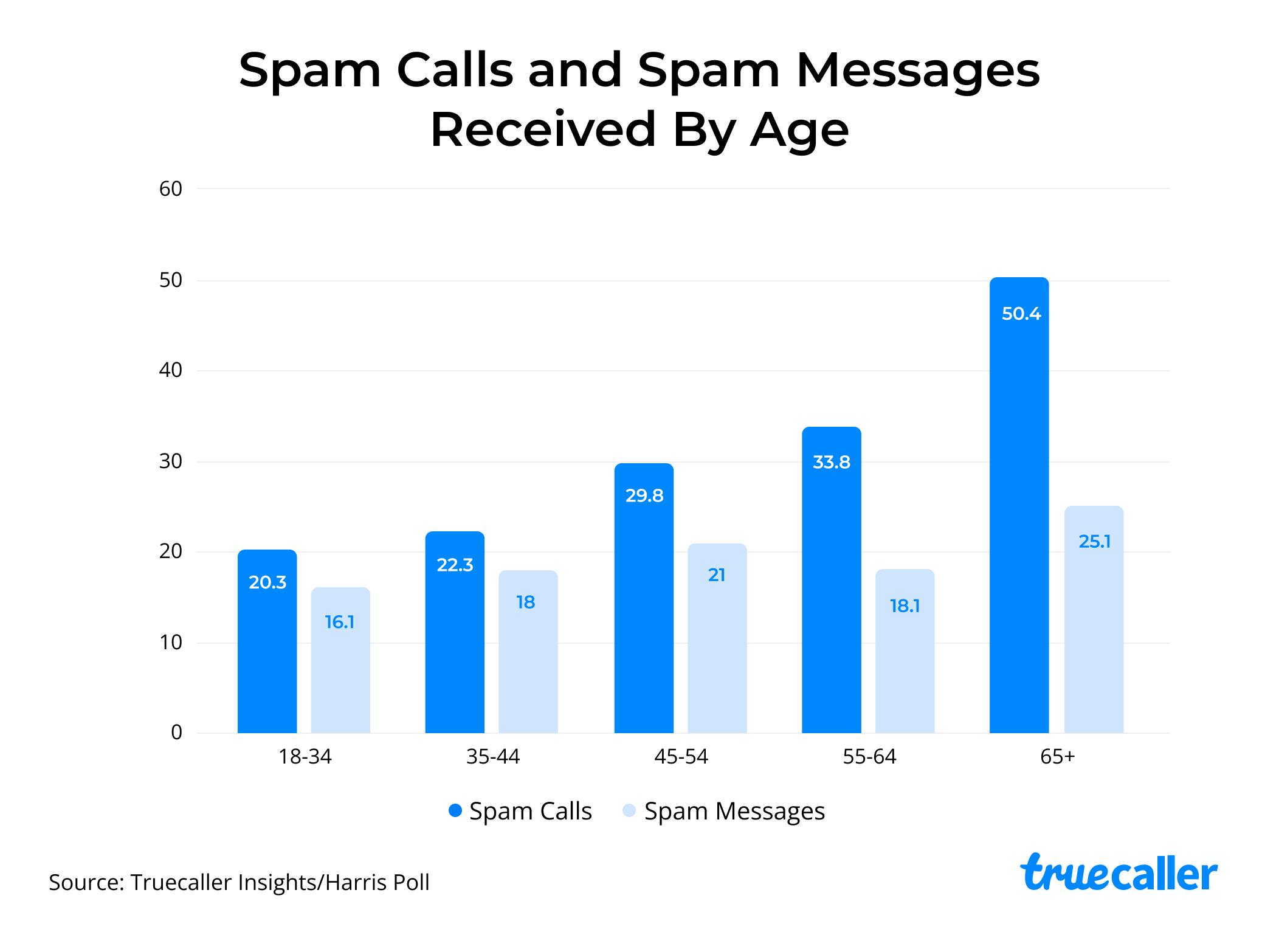
- Text Spam has more than doubled in the last 3 years. The biggest target for spam texts are males over 65 years old. In other age groups, there is more of a balance between genders. However, females between 18-34 are receiving more spam texts.
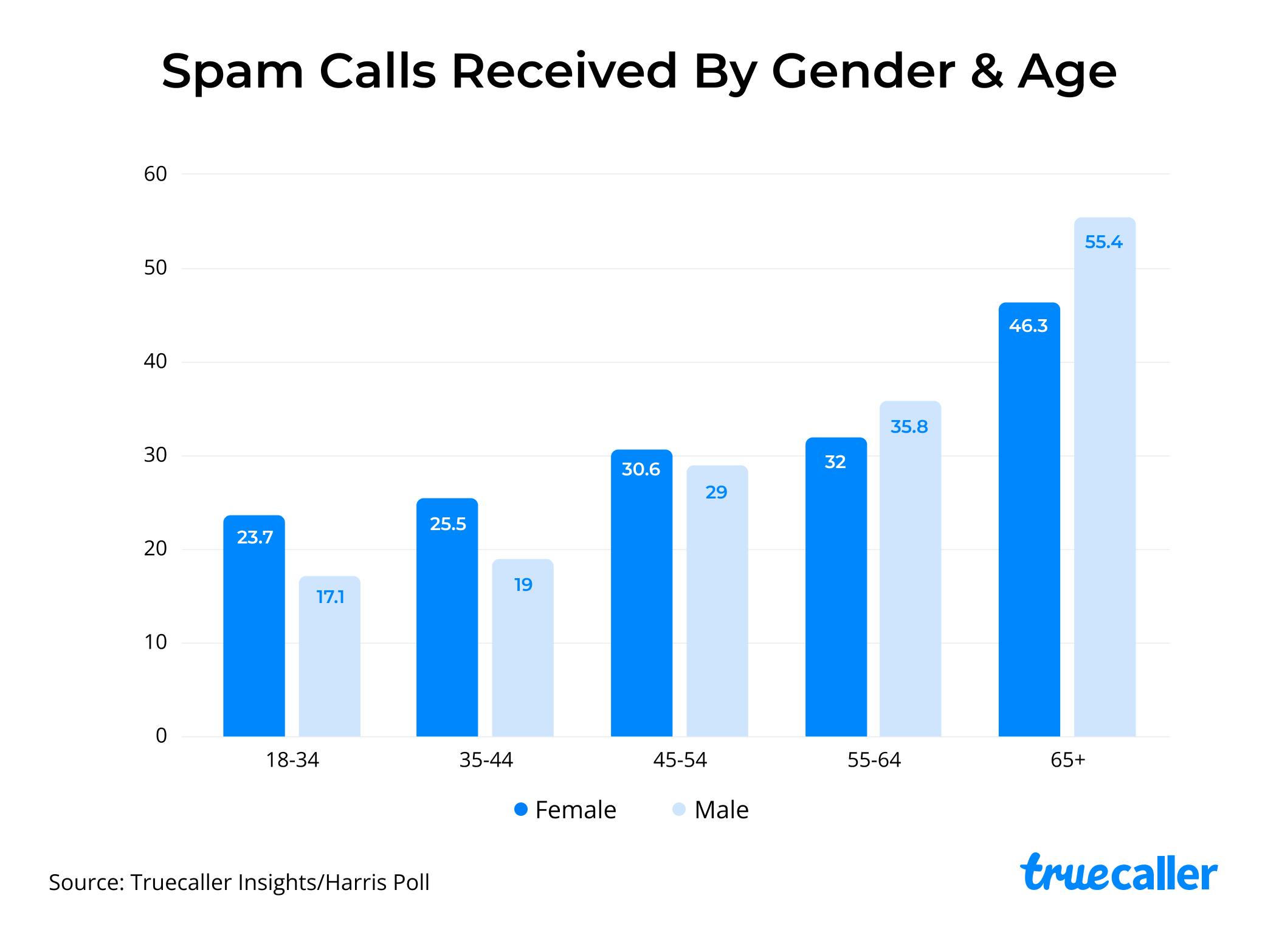
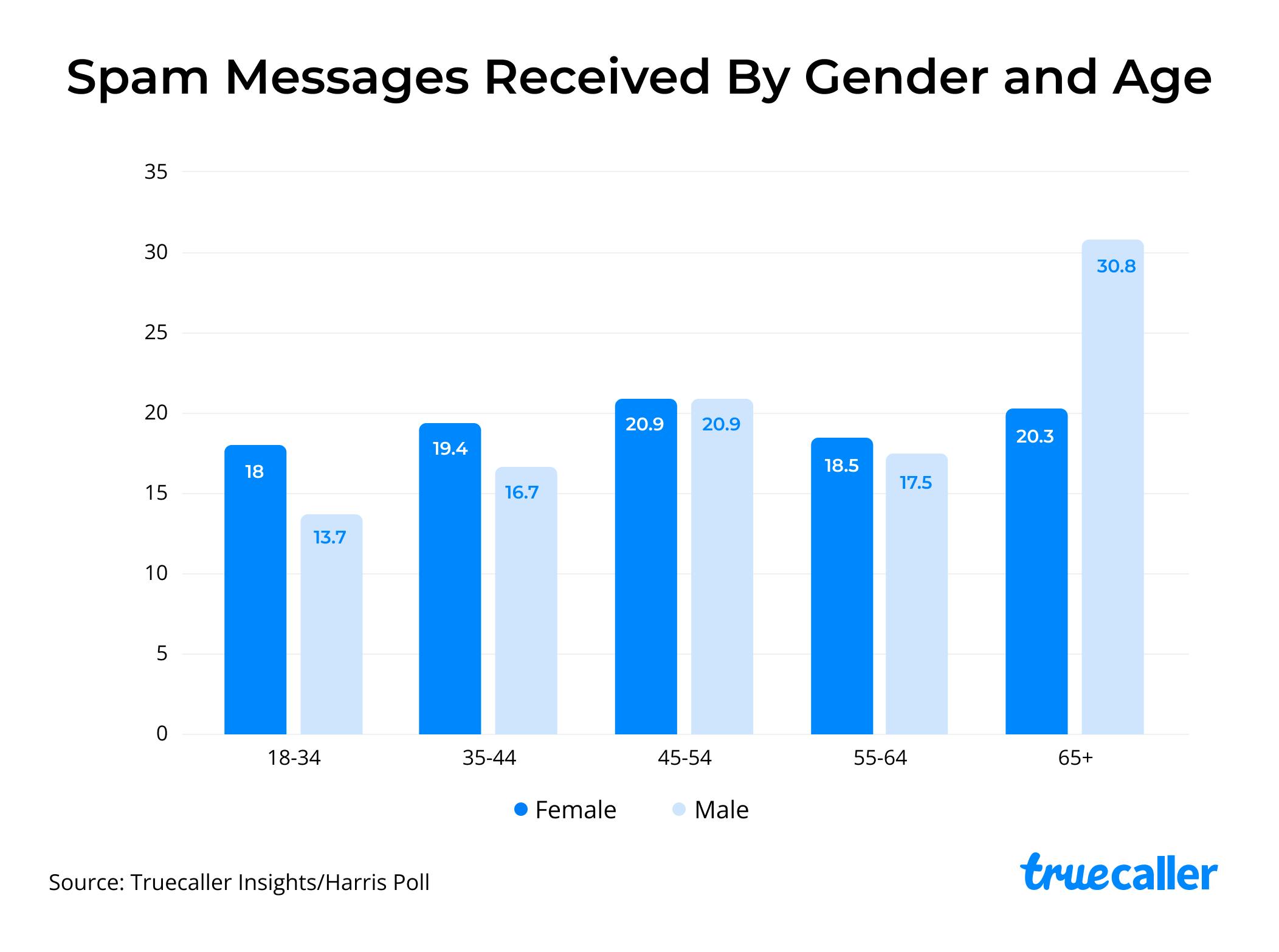
——————————————————————————————————————————
US Spam and Scam Report Survey Methodology:
The phone scam survey was conducted online within the United States by The Harris Poll on behalf of Truecaller from March 22-24, 2022. Among 2,065 adults aged 18 and older participated. The phone spam survey was conducted online within the United States by The Harris Poll on behalf of Truecaller from March 24-28, 2022. Among 3,075 adults ages 18 and older participated. These online surveys are not based on a probability sample. Therefore no estimate of theoretical sampling error can be calculated.
For complete survey methodology, including weighted variables and subgroup sample sizes, please contact press@truecaller.com.
Earlier surveys referenced – conducted online by The Harris Poll on behalf of Truecaller:
2021 phone scam survey – March 16-18, 2021, among 2,045 U.S. adults
2021 phone scam survey – March 18-22, 2021, among 2,002 U.S. adults
2020 phone scam survey – March 20-24, 2020, among 2,024 U.S. adults
2020 phone spam survey – March 19-20, 2020, among 2,050 U.S. adults
2019 phone scam survey – March 19-21, 2019 among 2,030 U.S. adults
2019 phone spam survey – March 21-25, 2019 among 2,040 U.S. adults
2018 phone scam survey – March 13-15, 2018 among 2,036 U.S. adults
2018 phone spam survey – March 22-26, 2018 among 2,049 U.S. adults
2015 phone spam survey – November 17-19, 2015 among 2,104 U.S. adults
2014 phone scam survey – July 18-22, 2014 among 2,040 U.S. adults
* 2022 International Data Base US Census Population Estimates showed a U.S. adult population (ages 18 and older) of 263,061,531. Based on 26 percent of U.S. adults reporting losing money in a phone scam, the total number of phone scam victims in the U.S. was estimated to be 68,395,998. The average phone scam victim in the survey reported losing $577. This equates to a total of $39.5 billion
You can find earlier reports here: https://truecaller.blog/category/truecaller-insights/
US Spam and Scam Report DISCLAIMER:
The content of this document is for general informational purposes only. Truecaller makes no representation or warranty whatsoever including as to the accuracy, completeness or adequacy of the information contained in this document. Truecaller disclaims all warranties including of accuracy, completeness, merchantability or fitness for a particular purpose with respect to any information contained in this document. Truecaller is not acting as your advisor, agent or fiduciary and no legal relationship between you and Truecaller shall be created by virtue of the information contained in this document. Any information contained in the document, and any opinions and estimates by Truecaller therein, should be regarded as indicative, preliminary and for illustrative purposes only. Any mark or other intellectual property contained in the document belongs to its respective owner.
About Truecaller:
People use Truecaller to stay ahead. It helps them know who’s getting in touch, filter out unwanted calls and SMS, and focus on what really matters. The mobile apps offer Caller ID, an intelligent dialer, spam blocking, messaging and more. Truecaller’s mission is to build trust everywhere by making communication smarter, safer and efficient. Headquartered in Stockholm, Sweden, the company was founded in 2009 by Alan Mamedi and Nami Zarringhalam. Investors include Sequoia Capital, Atomico and Kleiner Perkins.
About The Harris Poll:
The Harris Poll is one of the longest running surveys in the U.S. tracking public opinion, motivations and social sentiment since 1963. It is now part of Harris Insights & Analytics, a global consulting and market research firm. We strive to reveal the authentic values of modern society to inspire leaders to create a better tomorrow. We work with clients in three primary areas; building a twenty-first-century corporate reputation, crafting brand strategy and performance tracking, and earning organic media through public relations research. Our mission is to provide insights and advisory to help leaders make the best decisions possible. Learn more at http://www.theharrispoll.com.

Truecaller
May 24, 202212 min read


